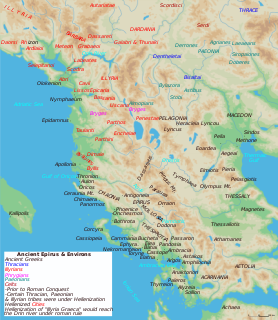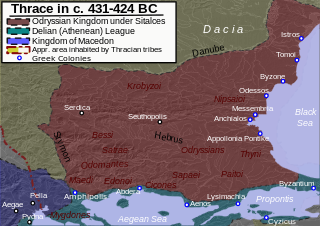Artakioi was a Moesian tribe mentioned in the Roman period. [1] Cassius Dio (155–235) mentioned the tribe. [1] The ethnonym has been connected with the Roman-era toponyms Artiskos (a tributary of the Maritsa) and Artanes (a tributary of the Danube). [2] The tribe inhabited the region of the upper Tundzha river, a tributary of Maritsa. [3] It is believed that they spoke a Thracian language. [4]
The Moesi was a Thracian tribe which inhabited present day Northern Bulgaria and Serbia, which gave its name to the Roman province of Moesia after its defeat in 29 BC. Moesia was first established as a separate province in 45–46 AD.
Cassius Dio or Dio Cassius was a Roman statesman and historian of Greek origin. He published 80 volumes of history on ancient Rome, beginning with the arrival of Aeneas in Italy. The volumes documented the subsequent founding of Rome, the formation of the Republic, and the creation of the Empire, up until 229 AD. Written in Ancient Greek over 22 years, Dio's work covers approximately 1,000 years of history. Many of his 80 books have survived intact, or as fragments, providing modern scholars with a detailed perspective on Roman history.

The Maritsa, Meriç or Evros is, with a length of 480 km (300 mi), the longest river that runs solely in the interior of the Balkans. Its drainage area is about 53,000 km2 (20,000 sq mi), of which 66.2% in Bulgaria, 27.5% in Turkey and 6.3% in Greece. It has its origin in the Rila Mountains in Western Bulgaria, flowing southeast between the Balkan and Rhodope Mountains, past Plovdiv and Parvomay to Edirne, Turkey. East of Svilengrad, Bulgaria, the river flows eastwards, forming the border between Bulgaria and Greece, and then between Turkey and Greece. At Edirne, the river flows through Turkish territory on both banks, then turns towards the south and forms the border between Greece on the west bank and Turkey on the east bank to the Aegean Sea. Turkey was given a small sector on the west bank opposite the city of Edirne. The river enters the Aegean Sea near Enez, where it forms a river delta. The Tundzha is its chief tributary; the Arda is another one. The lower course of the Maritsa/Evros forms part of the Bulgarian-Greek border and most of the Greek–Turkish border. The upper Maritsa valley is a principal east-west route in Bulgaria. The unnavigable river is used for power production and irrigation.









